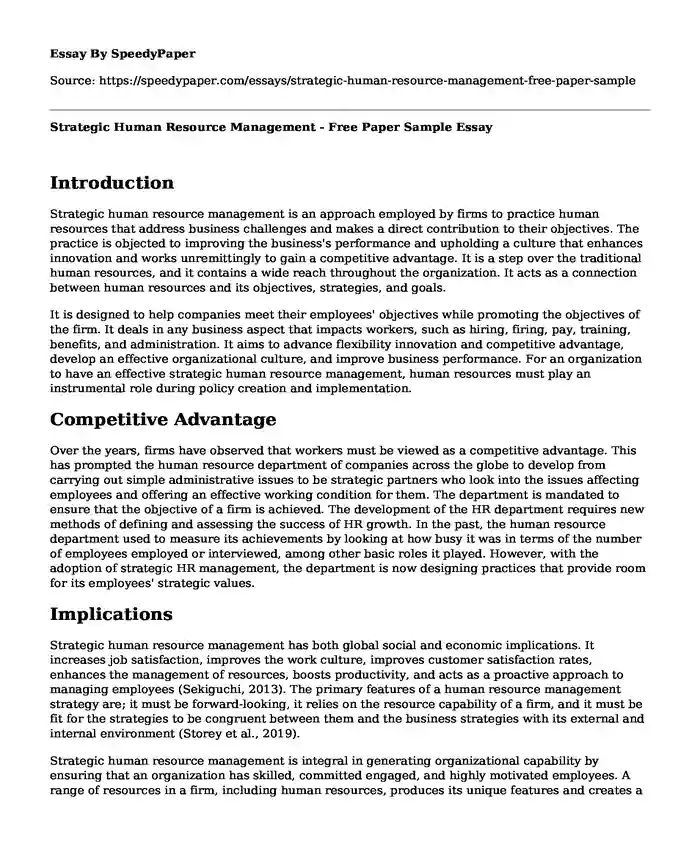
| Type of paper: | Essay |
| Categories: | Human resources Strategic management Business management |
| Pages: | 3 |
| Wordcount: | 659 words |
Introduction
Strategic human resource management is an approach employed by firms to practice human resources that address business challenges and makes a direct contribution to their objectives. The practice is objected to improving the business's performance and upholding a culture that enhances innovation and works unremittingly to gain a competitive advantage. It is a step over the traditional human resources, and it contains a wide reach throughout the organization. It acts as a connection between human resources and its objectives, strategies, and goals.
It is designed to help companies meet their employees' objectives while promoting the objectives of the firm. It deals in any business aspect that impacts workers, such as hiring, firing, pay, training, benefits, and administration. It aims to advance flexibility innovation and competitive advantage, develop an effective organizational culture, and improve business performance. For an organization to have an effective strategic human resource management, human resources must play an instrumental role during policy creation and implementation.
Competitive Advantage
Over the years, firms have observed that workers must be viewed as a competitive advantage. This has prompted the human resource department of companies across the globe to develop from carrying out simple administrative issues to be strategic partners who look into the issues affecting employees and offering an effective working condition for them. The department is mandated to ensure that the objective of a firm is achieved. The development of the HR department requires new methods of defining and assessing the success of HR growth. In the past, the human resource department used to measure its achievements by looking at how busy it was in terms of the number of employees employed or interviewed, among other basic roles it played. However, with the adoption of strategic HR management, the department is now designing practices that provide room for its employees' strategic values.
Implications
Strategic human resource management has both global social and economic implications. It increases job satisfaction, improves the work culture, improves customer satisfaction rates, enhances the management of resources, boosts productivity, and acts as a proactive approach to managing employees (Sekiguchi, 2013). The primary features of a human resource management strategy are; it must be forward-looking, it relies on the resource capability of a firm, and it must be fit for the strategies to be congruent between them and the business strategies with its external and internal environment (Storey et al., 2019).
Strategic human resource management is integral in generating organizational capability by ensuring that an organization has skilled, committed engaged, and highly motivated employees. A range of resources in a firm, including human resources, produces its unique features and creates a competitive advantage. It delivers an added value and assists in achieving sustainable competitive advantage via the strategic development of the firm's rare, and hard to replicate human resources. A resource that has the potential for generating sustained competitive advantage must have four attributes; it must be valuable, rare, non-sustainable, and non-replicable (Gupta, 2020).
Conclusion
Thus, effective strategic resource management produces a resource advantage to a firm, offers a practical justification for the fundamental aspects of the HR policies and practices of an organization such as human capital management, learning, knowledge management, talent management, and development. It also offers the three perspectives of human resource management. They entail universalistic perspective which states that some human resource practices are better than others and all organizations across the globe should embrace such practices; an effective contingency which enables HR policies to be consistent with other organizational aspects and the configuration of the human resource management to the structures and processes of the firm.
References
Gupta, A. D. (2020). Introduction to strategic human resource management. Strategic Human Resource Management, 1-30.
https://doi.org/10.4324/9780429327728-1
Sekiguchi, T. (2017). Theoretical implications from the case of performance-based human resource management practices in Japan: Management fashion, institutionalization, and strategic human resource management perspectives. The International Journal of Human Resource Management, 24(3), 471-486.
https://doi.org/10.1080/09585192.2012.703414
Storey, J., Wright, P. M., & Ulrich, D. (2019). Mapping the field of strategic human resource management. Strategic Human Resource Management, 1-14.
https://doi.org/10.4324/9780429490217-1.
Cite this page
Strategic Human Resource Management - Free Paper Sample. (2023, Nov 10). Retrieved from https://speedypaper.com/essays/strategic-human-resource-management-free-paper-sample
Request Removal
If you are the original author of this essay and no longer wish to have it published on the SpeedyPaper website, please click below to request its removal:
- Check the Interview with a Homeless Person in the Free Essay
- How to Write a Biography Essay Sample
- Spyros Papapetros - Free Essay on Architecture
- HRM Essay Example: Tanglewood's Staffing Strategy
- Essay Sample on Research Process Description on the Last Supper
- Essay Sample on Cognitive Development Experiment
- Essay on Managing with Analytics at Procter &Gamble
Popular categories




